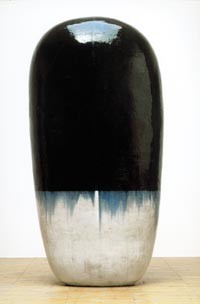Jun Kaneko
“Dangos on Display: Ceramicist Jun Kaneko shows in Sun Valley and Boise”
By Katy Dang
IAQ | September 2008
https://www.boiseweekly.com/boise/dangos-on-display/Content?oid=937872
Jun Kaneko still calls his gigantic ceramic sculptures “dangos,” a Japanese diminutive for “dumpling,” even though some of these oval-shaped, hollow-cast clay sculptures reach 13 feet in height and weigh hundreds of pounds. To refer to them in so playful a manner is a testament to how dear and personal these works are to the artist. Their grandiose size belies a quiet tranquility afforded by their presence; there is an intimacy in their form that draws viewers in.
Kaneko’s work appears in Idaho twice in 2008, affording viewers a double take on his compelling range. The Gail Severn Gallery in Sun Valley featured his work in July and continues to display his pieces. The Boise Art Museum will celebrate his art from November 29 through February 8, 2009. “His work is magnificent,” says Sandy Harthorn, curator of art at BAM. “We have two of his pieces in our permanent collection, so it is a real thrill for us to have an exhibition of his work.” The show will be in the main galleries and will feature dangos, wall pieces and one of the new oversized heads that Kaneko has created recently.

Kaneko was born in Japan in 1942 and moved to California in 1963 to study painting. He became part of the ceramics scene in the San Francisco Bay Area, where artists pushed the imposed limits of ceramics from functional to abstract and increased the notions of scale. In the mid ’80s, Kaneko started experimenting with the dangos, firing them in the beehive kilns at Omaha Brickworks in Omaha, Neb. He soon settled in Omaha, where he married Ree Schonlau, founder of the Bemis Center for Contemporary Art. Now, he has studio space and room to store his pieces housed in a defunct Plymouth dealership, a former heating and cooling supply warehouse and several other downtown buildings, totaling about 165,000 square feet. The space is necessary for the various stages of Kaneko’s process, which can include up to four months of drying time and a 35-day firing process.
In Omaha, Kaneko has found a home in the American heartland that allows him the space in which he can continue to explore his large-scale creations. His international success demonstrates quite clearly that artists do not need to reside in large cities on either coast in order to achieve the attention that they are due in the world of contemporary art. What they need, in addition to skill and talent, is the space to achieve their visions and create their work.
The combination of painting and clay work coalesce in Kaneko’s pieces. He has not only become skilled in the techniques of large-scale firing, but is also commanding with glazes. His training as a painter shows in their application, and in the care that he takes in creating the patterns that will appear on his sculptures. The designs, like the structures themselves, are often simple, elegant and undeniably powerful.

It has taken him years to perfect the technical aspects of creating such enormous ceramic pieces. “I always tell people that he is equal parts scientist, engineer and artist,” says Gail Severn. “There are really two things to be considered. There is the difficult task of forming the clay and creating the infrastructure. Then, there are the glazes and patterns, which are as integral to his work as the physical structure. Trying to determine what the glazes will do during the firing, and how the colors will interrelate and juxtapose, takes real mastery of the process.” Even with careful planning and preparedness, as few as two out of 10 dangos make it through the process of creation to Kaneko’s satisfaction.
In addition to ceramics, painting and drawing, Kaneko also works in glass and has done costume and set design, as he did for the Opera Omaha production of Madame Butterfly. Public commissions for his work have ranged from airports and convention centers to subway stations. A wall of the Salt Palace in Salt Lake City incorporates his work. Three of his dangos, called Heads, are currently on display along Park Avenue in New York City as part of the Art in the Parks program through October 31.

Kaneko’s former teacher at the University of California, Berkeley, the late renowned ceramicist Peter Voulkos, told Ceramics Today, “Kaneko’s ceramic works are an amazing synthesis of painting and sculpture. His works are enigmatic and elusive, simultaneously restrained and powerful, Eastern and Western, static and alive, intellectual and playful, technical and innovative.” It is precisely these dualities that make the tender term of endearment—dango—appropriate for these massive creations.
“Everyone wants to touch them, from 4-year-olds on up,” says Severn. “There is something that is just so enticing about caressing these enormous figures. The great thing is that because they are ceramic, you can.”



